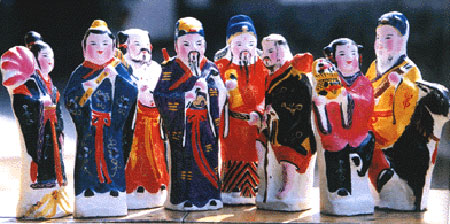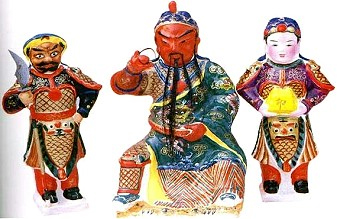Huishan clay figurines include fine and coarse figurines. Coarse figurines are made from moulds and produced in large numbers. However, fine figurines are made by hand in the shapes of oxen, tigers, the God of Longevity and so on. Generally speaking, Huishan clay figurines are short in stature, full with big heads, and their facial expressions are vividly depicted. Bright red, yellow, green and blue colors are applied to them to make them more distinct and beautiful.
One piece particularly representative of Huishan clay figurines is Da A Fu, meaning "great good fortune." It features two lovely, plump children, a boy and a girl, each holding a tiny lion. The figurine is considered a symbol of happiness and auspiciousness. In 1992, it was made the official mascot of China International Tourism Year.
 Gaomi clay figurines
Gaomi clay figurines


Gaomi (a place in Shandong) clay figurines have a history of 400 years. In the Long Qing and Wan Li periods of the Ming dynasty, farmers in Gaomi designed a kind of skyrocket. People put powder into the clay idols, which were in the shapes of various animals, such as the tiger, lion, monkey, dog and some legendary figures. After fired, the idols were collected by people as decorations.
Gradually, the figurines were no longer the appendants of fireworks, but developed into a kind of independent handicraft. In the Qian Long's reign of Qing Dynasty, the local artists used the experience of Yang village's New Year Picture for reference, and made some innovations in expressions as well as colorations.
At present Gaomi clay sculptures have become a folk art and is protected and often exhibited in foreign countries.

